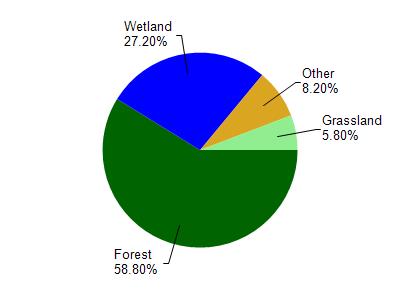Lincoln
No
No
No
Fish and Aquatic Life
Overview
, in the Prairie River Watershed, is a 11.31 acre lake that falls in Lincoln County. This lake is managed for fishing and swimming and is currently not considered impaired.
Date 2011
Author Aquatic Biologist
Historical Description
Source: 1982, Surface Water Resources of Lincoln County Larson Lake, T33N, R7E, Sec. 31 Surface Acres = 11.4, Maximum Depth = 41 feet, Secchi Disc = 5 feet.
A very soft water seepage lake having acid, light brown water of low transparency. The shoreline is 75 percent upland, consisting mostly of grass with some mixed hardwoods and conifers and 25 percent wetland of coniferous and shrub bog. The entire littoral zone is muck. There is an intermittent outlet, Black Alder Creek. Unimproved or difficult public access is possible from a wayside with parking on the northeast shore. There is one dwelling and a highway wayside and picnic site on the shoreline. A hypolimnetic aerator installed in February 1973 improved dissolved oxygen conditions from a point of occasional winterkill to habitat suitable for trout. In the fall of 1976 the lake was treated with rotenone to remove undesirable fish and will be managed as a trout lake.
Date 1982
Author Surface Water Inventory Of Wisconsin
Condition
Wisconsin has over 84,000 miles of streams, 15,000 lakes and milllions of acres of wetlands. Assessing the condition of this vast amount of water is challenging. The state's water monitoring program uses a media-based, cross-program approach to analyze water condition. An updated monitoring strategy (2015-2020) is now available. Compliance with Clean Water Act fishable, swimmable standards are located in the Executive Summary of Water Condition in 2018. See also the 'monitoring and projects' tab.
Reports
Management Goals
Wisconsin's Water Quality Standards provide qualitative and quantitative goals for waters that are protective of Fishable, Swimmable conditions [Learn more]. Waters that do not meet water quality standards are considered impaired and restoration actions are planned and carried out until the water is once again fishable and swimmable
Management goals can include creation or implementation of a Total Maximum Daily Load analysis, a Nine Key Element Plan, or other restoration work, education and outreach and more. If specific recommendations exist for this water, they will be displayed below online.
Monitoring
Monitoring the condition of a river, stream, or lake includes gathering physical, chemical, biological, and habitat data. Comprehensive studies often gather all these parameters in great detail, while lighter assessment events will involve sampling physical, chemical and biological data such as macroinvertebrates. Aquatic macroinvertebrates and fish communities integrate watershed or catchment condition, providing great insight into overall ecosystem health. Chemical and habitat parameters tell researchers more about human induced problems including contaminated runoff, point source dischargers, or habitat issues that foster or limit the potential of aquatic communities to thrive in a given area. Wisconsin's Water Monitoring Strategy was recenty updated.
Grants and Management Projects
Monitoring Projects
| WBIC | Official Waterbody Name | Station ID | Station Name | Earliest Fieldwork Date | Latest Fieldwork Date | View Station | View Data |
|---|
| 1483200 | Larson Lake | 353121 | Larson Lake - Deep Hole | | | Map | Data |
| 1483200 | Larson Lake | 10020364 | Larson Lake -- Access | 6/14/2023 | 6/12/2025 | Map | Data |
| 1483200 | Larson Lake | 10003415 | Larson Lake | 7/27/1999 | 6/14/2023 | Map | Data |
|

Watershed Characteristics
Larson Lake is located in the Prairie River watershed which is 263.99 mi². Land use in the watershed is primarily forest (58.80%), wetland (27.20%) and a mix of grassland (5.80%) and other uses (8.20%). This watershed has 273.14 stream miles, 2,082.78 lake acres and 34,162.59 wetland acres.
Nonpoint Source Characteristics
This watershed is ranked Medium for runoff impacts on streams, Medium for runoff impacts on lakes and Low for runoff impacts on groundwater and therefore has an overall rank of Low. This value can be used in ranking the watershed or individual waterbodies for grant funding under state and county programs.However, all waters are affected by diffuse pollutant sources regardless of initial water quality. Applications for specific runoff projects under state or county grant programs may be pursued. For more information, go to surface water program grants.